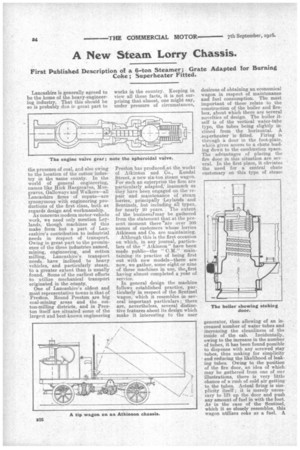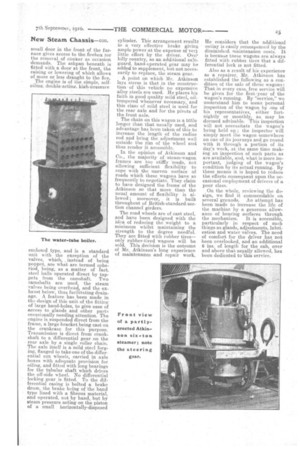A New Steam Lorry Chassis.
Page 4

Page 5

If you've noticed an error in this article please click here to report it so we can fix it.
First Published Description of a 6-ton Steamer ; Grate Adapted for Burning Coke ; Superheater Fitted.
Lancashire is generally agreed to be the home of the heavy-engineering industry. That this should be so is probably due in great part to the presence of coal, and also owing to the location of the cotton industry in the •same county. In the world of general engineering, names like Hick HargreaVes, Musgraves, Galloways and Walkers—all Lancashire firms of repute—are synonymous with engineering productions of the first class, both as regards design and workmanship. As concerns modern motor-vehicle work, we need only mention Leylands, though machines of this make form but a part of Lancashire's contribution to industrial needs in. respect of transport. i
Owing n great part to the prominence of the three industries named, mining, engineering, and cotton milling, Lancashire's transport needs have inclined to heavy vehicles, and particularly steam., to a greater extent than is usually found. Some of the earliest efforts to utilize mechanical transport originated in the county.
One of Lancashire's oldest and most representative towns is that of Presiton. Round Preston are big coal-mining areas and the cotton-milling districts, and in Preston itself are situated some of the largest and best-known engineering works in the country. Keeping in view all these facts, it is not surprising that almost, one might say, under pressure of circumstances,
• Preston has produced,at the works of Atkinson and Co., Kendal Street, anew six-ton steam wagon. For such an enterprise the firm are particularly adapted, inasmuch as they have been engaged on the repair and maintenance of steam lorries, principally Leylands and Sentinels, but including_ all types, for nearly 20 years. The extent of the business? may be gathered from the statement that at the present moment thereare over 300 names of customers whose lorries Atkinson and Co. are maintaining.
Although this is the first occasion on which, in any journal, particulars of the " Atkinson" have been made public—the "CM." maintaining its practice of being first out with new models—there are now, we gather, some eight or nine of these machines in use, the,first having almost completed a year of service.
In general design the machine follows established practice, particularly in respect of the Sentinel wagon, which it resembles in several important particulars ; there are, nevertheless, several distinctive features about its design which make it interesting to the user desirous of obtaining an economical wagon in respect of maintenance and fuel consumption. The most important of these relate to the construction of the boiler and firebox, about which there are several novelties of design. The boiler itself is of the vertical water-tube type, the tubes being slightly in. dined from the horizontal. A
.superheater is fitted. Firing is through a door in the foot-plate, which gives access to a chute leading down to the combustion space. The advantages of placing the fire door in this situation are so oral, In the first place, it obviates the need for a central chute customary on this type of steam
generator, thus allowing of an increased number of water tubes and increasing the cleanliness of the inside of the cab. Incidentally, owing to the increase in the number of tubes, it has been found possible to dispense with any screwed stay tubes, thus making for simplicity and reducing the likelihood of leaking tubes. Owing to the position of the fire door, an idea of which may be gathered from one of our illustrations, there is very little chance of a rush of cold air getting to the tubes. Actual firing is simplicity itself ; it is merely necessary to lift up the door and push any amount of fuel in with the foot. As in the case of the Sentinel, which it so closely resembles, this wagon utilizes coke as a fuel. A small door in the front of the furnace gives access to the. firebox tor the removal of clinker as occasion demands. The ashpan beneath is fitted with a door at the front, the raising or lowering of which allows of more or less draught to the fire.
The engine is of the siinple, selfoiling. double-acting. high-pressure enclosed type, and is a standard Unit, with the exception of the valves, which, instead of being poppet, are what are termed spheriod, being, as a mat-ter of fact, steel balls operated direct by tappets from the camshaft. Two camshafts are used, the steam valves being overhead, and the exhaust below, thus facilitating drainage. A feature has been made in the design of this unit of the fitting of large hand-holes, to give ease of access to glands and other parts occasionally needing attention. The engine is suspended direct from the frame, a large bracket being cast on the crankcase for this purpose. Transmission is direct from crankshaft to a differential gear on the rear axle by a single roller chain. The axle itself is a mild steel forging, flanged to take one of the differential sun wheels, carried in axle boxes with adequate provision for oiling, and fitted with long bearings for the tubular shaft which drives the off-side wheel. No differential locking gear is fitted. To the differential casing is bolted a brake drum, the brake being of the band type lined with a fibrous material, and operated, not by hand, but by steam pressure acting on the piston of a small horizontally-disposed cylinder. This arrangement results io a very effective brake giving ample power at the expense of vory little effort by the driver. Over hilly country, as an additional safeguard, hand-operated gear may be added to supplement, but not necessarily to replace, the steam gear.
A point on which Mr. Atkinson lays stress is that in the construction + of this vehicle no expensive alloy steels are used. He places his faith in good quality mild steel, oiltempered whenever necessary, and this class of mild steel is used for the rear axle and for the pivots of the front axle.
The chain on this wagon is a little longer than that usually used, and th advantage has been taken of is to increase the length of the radius rod and bring the adjustment well outside the rim of the wheel and thus render it accessible.
In the opinion of Atkinson and Co., the majority of steam-wagon frames are too stiffly -made, not allowing sufficient flexibility to cope with the uneven surface of roads which these wagons have so frequently to negotiate. They claim to have designed the frame of the Atkinson so that more than the usual amount of flexibility is allowed ; moreover, it is built throughout of British-standard-section channel girders.
The road wheels are of cast steel, and have been designed with the idea of reducing the weight to a minimum whilst maintaining the strength to the degree needful. They are fitted with rubber tires— only rubber-tired wagons will be sold. This decision is the outcome of Mr. Atkinson's long experience of maintenance and repair work. He considers that the additional outlay is easily recompensed by the diminished. maintenance costs. It is beca.use these wagons are always fitted with rubbei tires that a differential lock is not fitted.
Also as a result of his experience as a repairer, Mr. Atkinson has established the following as a condition of the sale of these wagons : That in -every ease, free service will be given for the first-year of the wagon's running. By "service," wo understand him to Mean Personal inspection of the wagon by one of his representatives, either fortnightly or monthly, as may be deemed advisable. This inspection will not necessitate the wagon's being held up the inspector will simply meet the wagon .somewhere on one of its journeys and go round with it through a portion of its days work, at, the same time making an inspection of such parts as are available, and, what is more important, judging of the wagon's condition by its actual running. By these means it is hoped to reduce the effects _consequent upon the occasional employment of drivers of a poor class. • On the whole, reviewing the design, we find it commendable on. several grounds. An attempt has been .made to increase the life of the machine by a generous allowance of bearing surfaces through
the mechanism. It is accessible, particularly in respect of such things as glands, adjustments, lubrication and water valves. The need of comfort for the driver has not been overlooked, and an additional 6 ins. of length for the cab, over and above that usually allowed, has been dedicated tOthis service.




















